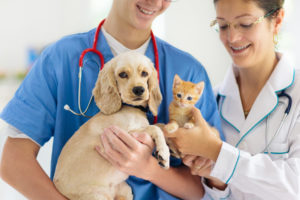
This blog post discusses mammary cancer in pets.
Since October is Breast Cancer Awareness Month for humans, did you know that dogs and cats can also get breast cancer too? A mammary tumor forms due to abnormal replication of the cells that compose the breast tissues. They can either be non-cancerous or cancerous. So, what causes this cancer? Read on to understand mammary cancer in pets.
Signs & Symptoms of Mammary Cancer in Pets
The most prevalent clinical sign of a tumor is one or several nodules below the abdomen’s skin. They might be following or within the nipple area. Occasionally, the skin above the mass might open and bleed. Your pet might tend to lick and groom the affected area excessively, and a potent odor can result as the tissue becomes infected. Moreover, other signs may develop if the mammary tumor has spread to other body areas. Your pet can generally eat less, lose weight, feel unwell, and become lethargic. They may also develop a cough.
Diagnosis
Tumors are typically found by pet owners or during a physical exam. Upon examination, one of our veterinarians might determine if the mass is in the skin or if the mammary gland is there. Our veterinarian may also perform a fine needle aspirate of the mass. The doctor will insert a small needle to remove cells from the mass. This allows the doctor to examine the cells under the microscope to help determine if the mass is benign or cancerous. Other diagnostic tests, such as x-rays or ultrasounds, may also be performed to assess if there is any metastasis present.
While a fine needle aspirate can be helpful, the only way to definitely diagnose a tumor is to send a biopsy to a pathologist. This allows the pathologist to identify the specific type and stage of the cancer.
Treatment
Surgery is the best treatment for eliminating mammary cancer in pets. This is also the only way to send a biopsy for a pathologist to examine. Surgery can range from a lump removal if the tumor is localized to one spot or a full mastectomy if there are several tumors. A mastectomy in a dog or cat involves removing the entire mammary chain on one or both sides. In addition, chemotherapy may be necessary. Chemotherapy may be required if the surgeon is unable to fully excise the cancerous cells due to tumor size or location or if the tumors have a high metastatic rate.
Risk Factors
The exact causes of mammary tumors developing in both dogs and cats are not fully understood. At a cellular level, mammary tumors in cats and dogs are similar to human breast cancer tumors. However, exposure to female reproductive hormones increases pets’ risk of mammary cancer. This means that sexually intact pets have a higher risk for mammary tumors than spayed pets. So, early spaying assists in preventing tumor development. Ideally, the best way to minimize the risk of mammary cancer in pets is to spay your cat or dog at 6 months of age.
Here at Mount Carmel Animal Hospital, We’ll Treat Your Pets Like Family!
Mount Carmel Animal Hospital has been serving the Northern Baltimore/Southern York community for over 30 years and is proud to be an independently operated, small animal practice committed to excellence in veterinary medicine and client service. From grooming to wellness services, along with Canine Life Skills Training Courses, and surgical procedures, we have the expertise that will best serve the needs of you and your pet. Contact us at 410-343-0200 and follow us on Facebook!
